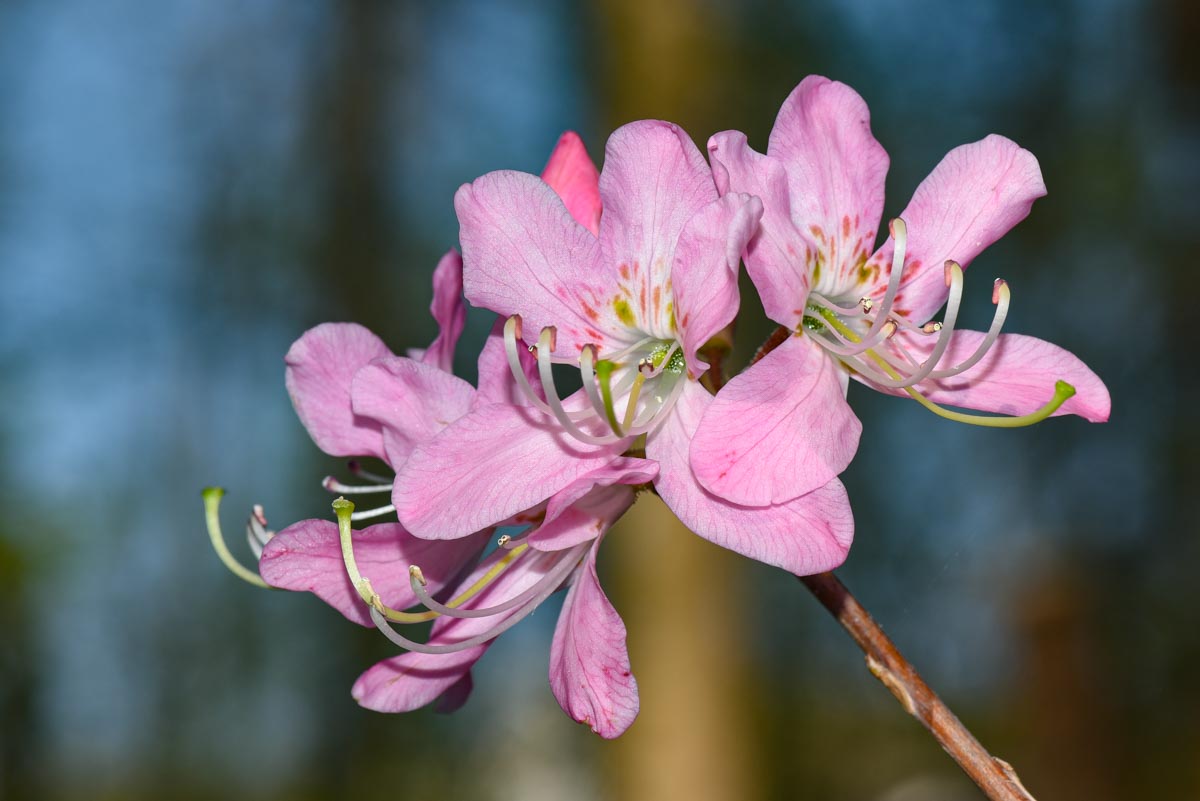This week is the culmination of a long wait. Finally, a pinkshell azalea is flowering in my garden. I grew a couple in my first garden in the early 1990s. They grew but never flowered in the five years I was there. I hadn’t tried again in my assorted gardens until last spring. When my mom passed away last year, I built a memorial garden for her.
One of the plants I chose to include in her garden is Azalea vaseyi, the pinkshell azalea. Azaleas have a special significance since we shared many great memories of them. A pair of deciduous azaleas framed the patio of my childhood home. To this day I haven’t discovered any plants that smell as sweet, an intoxicating blend of childhood and the beginning of summer.
She had moved ten years earlier to western North Carolina to be near me, and together we chose a perfect place for her to retire. In a community of around 600 people, she rekindled friendships with two college friends, discovering them only after she arrived. She made many new friends too, and though she enjoyed the privacy of her home she ate out most days with her friends. Covid protocols limited her activities, and she saw far less of me or her friends. Though she never had covid, I feel she suffered from the isolation in ways that may have contributed to declining health. To me it is a less acknowledged toll of the pandemic, with older people languishing from too much solitude.
Still, we had a wonderful decade of shared adventures while we were nearly neighbors. We drove past the native home of pinkshell azaleas near Asheville many times on shared drives through the nearby mountains. One of the easiest ways to see them is along the Blue Ridge Parkway, fondly known as the Appalachian Trail for cars. Because of elevation changes, spring drives mean you may pass flowers in full bloom at one location and barely in bud or past flowering in others. In addition to being an easy way to see plants, there are also incredibly beautiful mountain vistas which we both enjoyed in all seasons.
They aren’t officially considered endangered but grow in a very restricted area, endemic to the Blue Ridge Mountains of North Carolina. There are two main populations. One is in the northwest of the state, centered around Grandfather Mountain, a destination always worth a visit. The other is in the southwest, and this is considered the main center of their distribution. It is likely at least part of the disjunction is the lower elevation of the area between these two, with Asheville and the surrounding area only about 2000 feet in elevation. In the wild they are found only above around 3000 feet, and most commonly from 4000-6000 feet in elevation. They can be found on open mountainsides as well as under trees. They seem to like moist areas, often growing near springs and seeps. It could be this preference that makes their distribution limited in the wild. It has been theorized that the seedlings may need constant moisture to become established.
Despite their limited range in the wild, they do well in a variety of gardens. They grow in both the eastern and western US and Canada, from zones 5 to 8. They thrive in Europe, including a small slice of zone 9 in Denmark. My garden is near the center of distribution for this species, though it doesn’t grow in the wild in Tennessee. I bought this plant from Mountain Mist nursery in North Carolina, a fantastic source that focuses on native azaleas and companion plants.
Seeing them flower for the first time in my garden, this is a bittersweet week for me. I wish my mom was here to share them with me. Though I am missing her, I like the thought that she is in some ways living on in these flowers that share her graceful beauty. Because she isn’t here, I try to appreciate them twice as much, enough for both of us. I balance between sorrow and joy, and an intense awareness that life’s passages lead not only to endings but also new beginnings.
